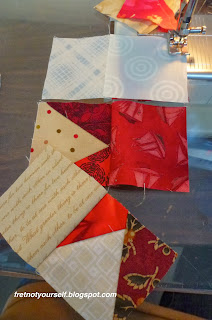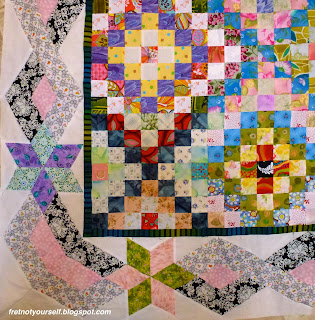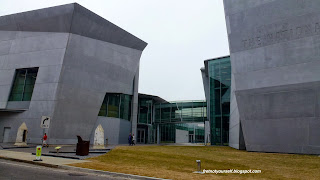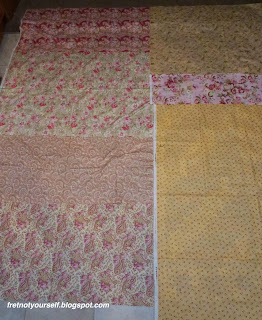I enjoy making scrap quilts. The seemingly random arrangement of fabrics interests me and I love the depth achieved by using fabrics that don't quite match. We are so much smaller than a quilt (no matter how large we think we are.) Mismatching colors in clothing looks weird most of the time but adds so much dimension to a quilt. When I work on blocks like the variable stars I take time to arrange the lights or darks in ways that add sparkle.
Sometimes, however, I lay out a scrap block in a particular order only to sew the wrong sections together. It's so annoying. Here's a way to avoid this problem.
1. Lay out the block as you'd like it.
 |
| The nine patches of this variable star block are laid out as I intend to sew them. |
2: Chain piece pairs of squares from the columns starting at the top left. Place the top left and middle left pieces right sides together and sew. Repeat with top middle and middle pieces, chain piecing them to the previous pair. Repeat again with the top right and middle right. Do NOT cut between these three chained pieces but cut after the third (right-most) one is sewn. (This is where I'd sew an ender to keep the thread from tangling.)
 |
| Chain piecing the two squares from each row. |
3. Finger press seams to opposite sides and open.
 |
The first two squares in the first two rows are sewed
and the thread is still chained between them. |
4. Now chain piece the next square in each column to the previous sewing. Place bottom right piece to the right section, right sides together and sew. Repeat with bottom middle piece and middle section, chain piecing them to the previous set. Repeat again with lower left piece and left section. Again, do NOT cut between the chained pieces but do cut after the third one is sewn. (Sew another ender.)
 |
Chain piecing the bottom squares
to each column.
Ender #1 is in the background. |
5. Finger press seams to opposite sides and lay open. The block is linked by the sewing thread you didn't cut. Everything should be in order.
 |
Two sets of chain piecing completed.
(Sorry, the columns look like rows
so you can see the chaining.) |
6. Place left and middle columns right sides together butting seams and sew. Sew an ender. Cut.
 |
Sewing two columns together.
Notice how chains hold the
third column in place on the left. |
7. Repeat with last column. Sew a fourth ender. Press and admire.
 |
Two columns sewed.
Ready to sew the last column. |
The block is now sewn in order. Yea!
This method works for any block that breaks down into squares such as four-, five-, seven-, nine-patches. And did you notice I sewed four enders making this one block? That's how I get so, so many scrap blocks finished {which is both a blessing and a curse.} Do you have questions? Let me know.
Wishing everyone peace and joy throughout the New Year.
Enjoy the day. Ann























